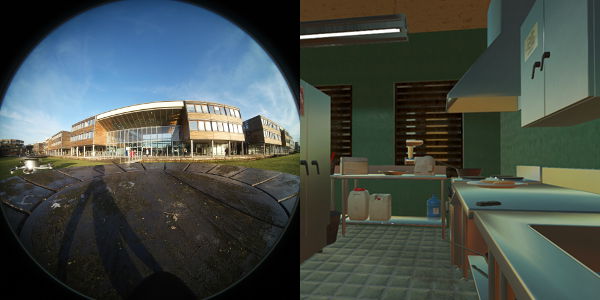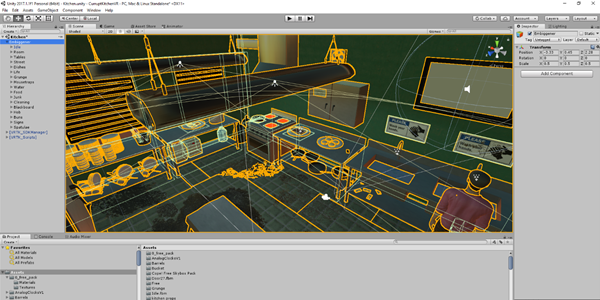
April 10, 2018, by Raphael Velt
Creating 3D environments for virtual experiences 1/2: 360° Video and 3D Modelling
As part of our goal to create a 3D bar for beer tasting experiments – described in our guest blog post by Marit Nijman, researcher in the Sensory Science Centre – we are currently experimenting with a variety of technologies that can be used to capture and recreate realistic 3D environments. In this blog post, we briefly introduce two of these technologies, 360 video and 3D modelling, and discuss their pros and cons – with two more techniques, 3D scanning and photogrammetry, described in an upcoming blog post. We also give examples of how these methods are being used at the University of Nottingham.
360° Video
This technique requires the use of a special camera, or camera rig, which has two or more lenses, producing two or more images that are then stitched together into a virtual sphere. The major benefits of this approach are its ability to capture live action (e.g. patrons in a pub chatting and/or ordering beer), and its low cost (consumer-grade 360 cameras cost around £200). The main drawback is that there is no interaction with the environment, which includes being unable to move from the single viewpoint corresponding to the position of the camera.
Examples of 360° Video
The University of Nottingham has produced 360° Videos for communication purposes (Experience the day of a student, Tour the School of Computer Science). You don’t need a VR headset to experience them at all, just open those on the YouTube app in your mobile phone and move your phone around to move your viewpoint.
3D Modelling
In this technique, which we’ve used for the Corrupt Kitchen Virtual Environment, an artist recreates all elements in the environment, including volumes (e.g. the chairs, tables and walls in the bar) and textures (e.g. the grain in the wood that the tables are made of) using 3D modelling software. This technique is time consuming and requires the intervention of one or several highly skilled professionals, making it expensive to use. It can, however, be made easier and quicker either by building upon a 3D environment captured through one of the other techniques below, or by importing “stock” 3D objects from third party libraries such as Turbosquid. The major benefit of this approach is that every object in the environment can be made interactive and will look good from every angle.
Examples of environment created through 3D modelling
Our blog on the Corrupt Kitchen explains how researchers in the Mixed Reality Lab have modelled the Paradise Café. Bar environments like the one we intend to recreate can also be found off the shelf on gaming platforms.

This blog is part of a series on Virtual Reality and Sensory Science.
Previous blog post in series: Creating a virtual bar for a beer tasting experiment
Next blog post in series: Creating 3D environments for virtual experiences 2/2: 3D Scanning and Photogrammetry (not published yet)
No comments yet, fill out a comment to be the first

Leave a Reply